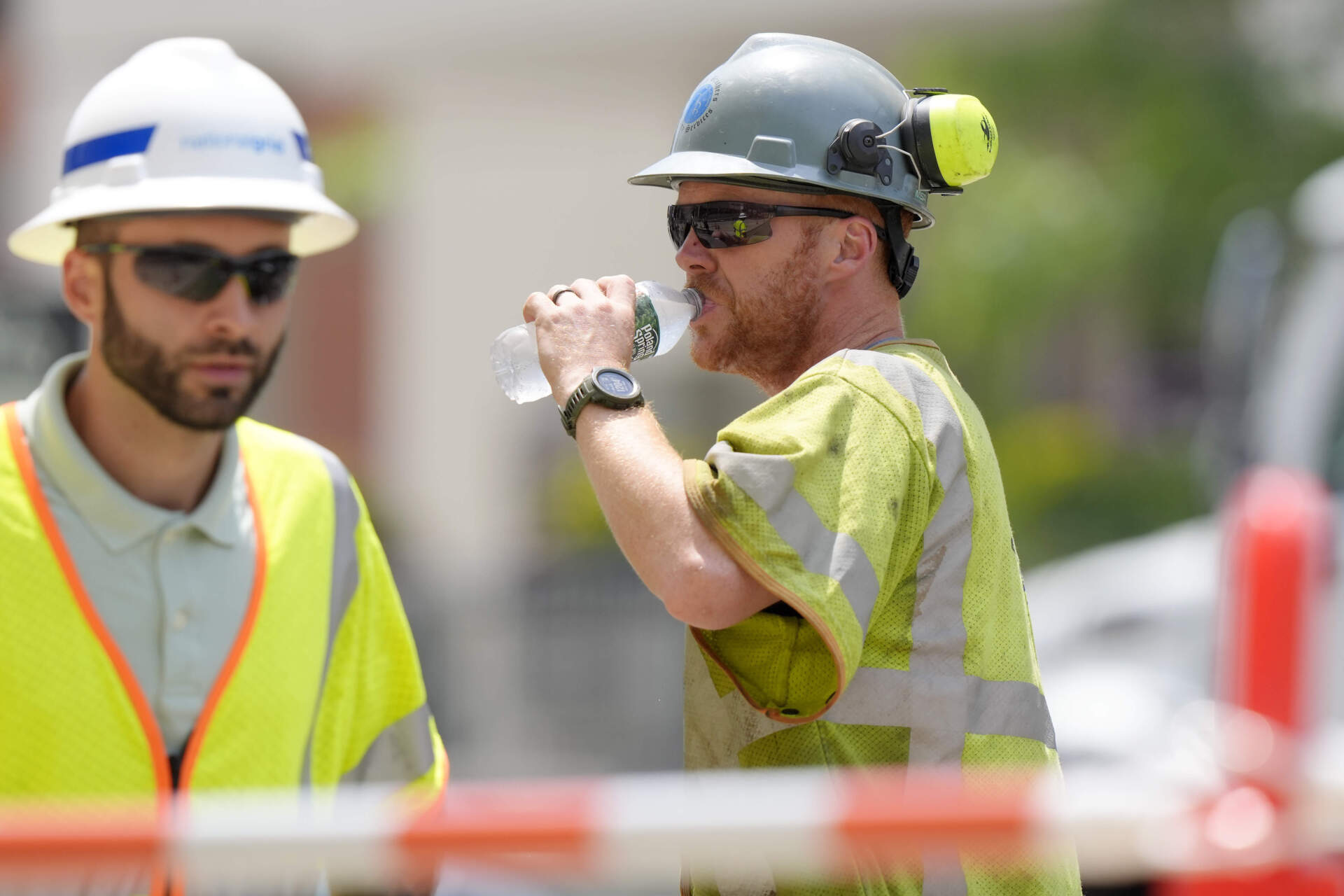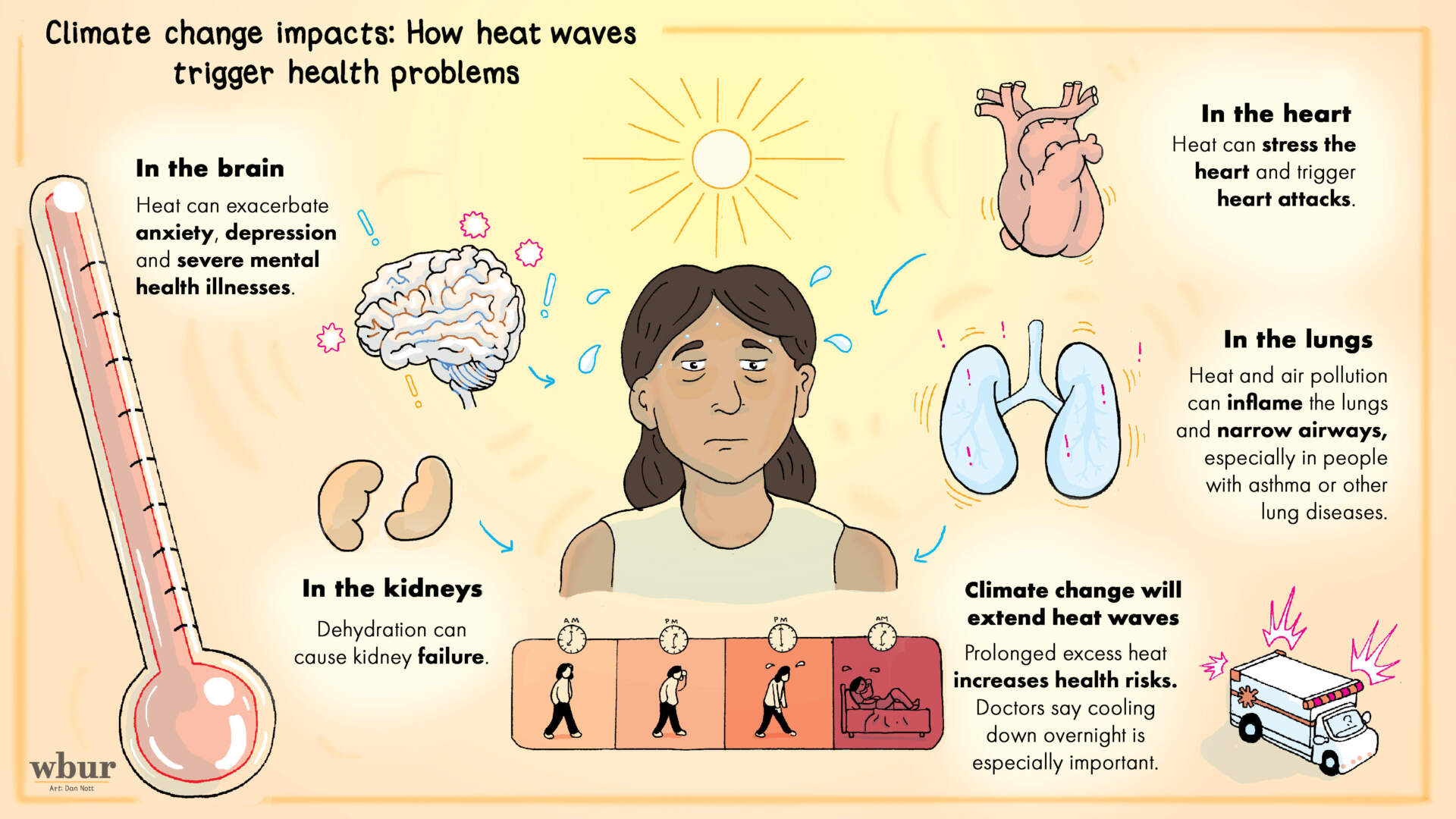Advertisement
Workers struggle to stay cool as summer heat continues to worsen

As summers get hotter, there is growing concern about the impact of excessive heat on workers, especially those who spend a lot of time outdoors.
There are state and federal efforts in the works to address this. In the meantime, extreme heat is happening more often across the U.S. Greater Boston has already had multiple heat waves this summer. In Boston, average summer temperatures have increased 1.4 degrees since 1970.
"My sense is definitely, in keeping with climate change, that more workers are complaining about higher and higher heat and humidity," said Rick Rabin, trainer and technical consultant at the workers' rights nonprofit Massachusetts Coalition for Occupational Safety and Health (MassCOSH).
Extreme heat can cause various forms of illness such as heat rash, dizziness, muscle damage, heat exhaustion and heat stroke. Experts agree that water, shade and rest are especially important to combat heat illness.
Workers in construction, agriculture or landscaping are particularly susceptible to the hot weather. But heat can also impact people who work indoors, in places like kitchens, bakeries or warehouses, where it can get very hot inside or there isn't air conditioning, according to Rabin. He said he often receives complaints from workers about a lack of water, shade and work breaks.
"It's very upsetting to see that something so basic as that — that's necessary for life — is denied for workers either because of language, because if they come from another country, or because simply because their employer is just oblivious or doesn't care about the health and welfare of their employees," said Rabin, who has been with MassCOSH for 40 years.
Workers who are immigrants or undocumented are especially vulnerable because they may be "working under abusive working conditions" or facing discrimination, said Rabin. That often makes them less likely to ask their employer for relief from the heat.
Rabin said employers should provide employees with frequent drinks of water, regular breaks and shade. MassCOSH also holds trainings to help workers learn about heat hazards, recognize the signs of heat stress, understand their rights and know how to protect themselves in hot conditions.

Some employers are reexamining how they deal with heat. Bill Shea, the safety director for E.M. Duggan, said the Canton-based mechanical contractor uses a federally approved heat app — called the OSHA NIOSH Heat Safety Tool — that measures the heat index near the user's phone and recommends precautions they can take to protect workers from the elements.
"We've certainly had to change our view on how we view the weather, especially in regards to heat. As you know, we've seen an increase in really hot days," Shea told WBUR. "We've had to retrain all of our foremen, retrain the way we think of things and let everyone know it's OK if you don't feel right, or something's not right to stop work and let your supervisor know."
Shea said 80% of E.M. Duggan's workers are outdoors and exposed to heat on any given day. The company has focused on putting together best practices for heat, which includes making sure workers take extra breaks in shade or an air conditioned area on high heat days, and having plenty of water on every job site. Shea said they also pay extra attention to certain employees like welders who do tasks that generate heat, and wear additional gear that can make them feel hotter.
Advertisement
"So far this summer we have had zero confirmed incidences of heat illness, which is a tip of the hat to our field foremen and field supervisors for monitoring our employees and, you know, making sure we're taking extra breaks," Shea said.
There's no federal or state standard for protecting workers in hot conditions. The Occupational Safety and Health Administration has a number of wide ranging workplace safety standards, which the state follows, but none specific to heat.
With extreme heat events becoming more common, there's increasing focus on protecting workers. The Biden administration recently proposed a new rule that would require employers to develop plans to address heat-related illness and hazards in the workplace. The proposal has received support from unions and pushback from business groups. And it will be an uphill battle getting the rule finalized in an election year.

At the state level, the Department of Labor Standards developed a working group on heat and worker safety two years ago. It developed best practices and outreach materials for employers. Now, it's piloting a heat illness prevention program with local public agencies. Department Director Michael Flanagan said the goal is to help employers understand heat conditions and give them strategies to manage outdoor work.
" So, for instance, if you're going to do lawn mowing, you would do it in the morning when it's shady," Flanagan said. "And then maybe do repairs and maintenance on the lawn mowers in the middle of the day. Then kind of late day, you might do some additional outdoor work."
The pilot program is underway now with the Bourne Water District, Littleton Housing Authority and Plymouth Department of Public Works. And the state hopes to expand it to other communities and employers, Flanagan said.
But while the department does offer some services for private businesses, it only has oversight over public sector employers. OSHA has oversight over private sector employers, according to Flanagan. This split — without a federal rule in place — could present a gap when it comes to combating the specific growing threat of excessive heat in the workplace.
Here are some tips for dealing with extreme heat in the workplace:
Tips for workers, via Rick Rabin of MassCOSH:
- Drink small amounts of water a few times an hour. It can be every 15-20 minutes or up to half an hour depending on the heat. Don't wait until you get thirsty to drink water.
- If you can, reduce the amount of work you do on very hot days where it's 90-95 degrees or higher.
- Go in the shade when you take a rest break.
- Talk to your employer as a group of employees about making sure there is water, rest and shade.
Tips for employers, via Michael Flanagan of DLS:
- Provide water, rest and shade as much as possible for your employees.
- Time work strategically throughout the day. So, for example, do heavy outdoor work in the morning or evening and indoor work during the hottest part of the day.
- Use the state's free on-site consultation program to help address possible health and safety hazards, and train employees. This is available to public and private employers.
With reporting from WBUR's Newscast Unit
